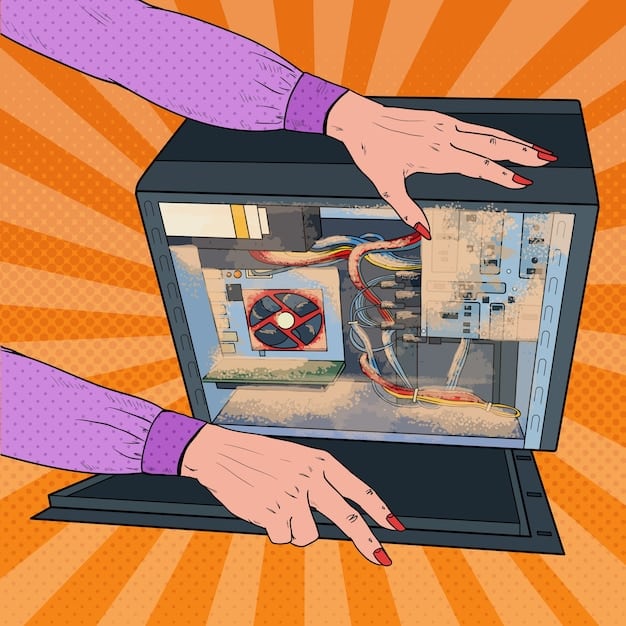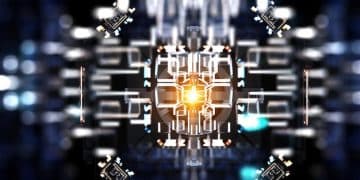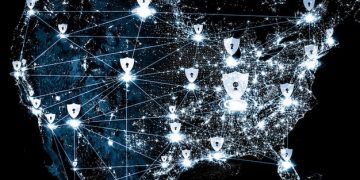Quantum Computing and US Cybersecurity: 2025 Threat Landscape

Quantum computing’s rapid advancement poses a dual threat to US cybersecurity by 2025, potentially breaking current encryption standards while also offering new methods to defend against cyberattacks, necessitating urgent adaptation and development of quantum-resistant cryptography.
The advent of quantum computing is poised to reshape the landscape of US cybersecurity by 2025. How prepared are we for this paradigm shift?
Quantum Computing: A Looming Threat by 2025
Quantum computers, with their unparalleled computational power, are no longer a distant dream. As they become increasingly viable, their potential impact on existing encryption methods, currently safeguarding sensitive data, looms large. The US must prepare.
Let’s delve into how this technology could compromise our digital defenses:
Shor’s Algorithm and Encryption
Peter Shor’s algorithm is a quantum algorithm that threatens many of the cryptographic systems we rely on today. This algorithm can efficiently factor large numbers, which is the basis for RSA and other public-key cryptosystems.
Breaking Current Encryption Standards
As quantum computers evolve, they could render current encryption protocols vulnerable. The security infrastructure is built on the computational difficulty of factoring certain large numbers and computing discrete logarithms, challenges that quantum computers might overcome.
- Quantum computers could break RSA: RSA is a widely used public-key cryptosystem; its vulnerability to quantum computers is a significant concern.
- Impact on ECC: Elliptic Curve Cryptography, another popular encryption method, is also susceptible to quantum attacks.
- Data breaches: Encrypted data stored today could be decrypted by quantum computers in the future, leading to large-scale compromises.
In conclusion, the imminent threat of quantum computing requires swift action. It’s important we understand the risks and secure defenses against them.

Developing Quantum-Resistant Cryptography
The US has a chance to take control on how to mitigate the risks of quantum computing by developing new encryption methods. These methods should resist quantum attacks, ensuring the security of information in the quantum era.
Here are some cryptographic solutions to consider:
Post-Quantum Cryptography (PQC)
PQC involves developing cryptographic systems that are secure against both quantum and classical computers. Numerous algorithms are being researched and developed to replace existing standards.
NIST’s PQC Standardization Process
The National Institute of Standards and Technology (NIST) is currently leading an effort to standardize PQC algorithms. This initiative aims to identify and promote cryptographic standards that can withstand quantum attacks.
- Key encapsulation mechanisms: Focusing on secure methods for key establishment.
- Digital signature schemes: Ensuring quantum-resistant authentication.
- Algorithm diversity: Exploring multiple algorithms to protect against unforeseen vulnerabilities.
In conclusion, developing quantum-resistant cryptography is necessary for cybersecurity practices. This approach could ensure security from emerging threats.
Quantum Key Distribution (QKD)
Quantum Key Distribution (QKD) offers a method to securely distribute encryption keys using the laws of quantum mechanics. This technology ensures that any attempt to intercept the key will be detected, making it immune to eavesdropping.
Discover how this technology works and its practical uses in cybersecurity:
How QKD Works
QKD uses single photons to transmit encryption keys. By encoding information on quantum states, any attempt to measure these states introduces detectable disturbances, alerting the parties involved.
Advantages of QKD
QKD provides unconditional security, meaning its security is based on the laws of physics rather than computational difficulty. It is immune to both classical and quantum computing attacks.
- Secure key exchange: Ensuring keys are exchanged without the risk of interception.
- Eavesdropping detection: Detecting any unauthorized attempts to access the key.
- Applications in critical infrastructure: Securing communications in sensitive sectors like finance and government.
Overall, Quantum Key Distribution is very beneficial to cybersecurity and is a great way to securely distribute encryption keys.
Enhancing Cybersecurity Defenses with Quantum Technology
Beyond the threats, quantum computing can also enhance cybersecurity defenses. Quantum technologies can provide novel approaches to threat detection and data analysis.
Let’s explore some promising possibilities:
Quantum Machine Learning
Quantum machine learning algorithms can analyze large datasets faster and more efficiently than classical algorithms. These algorithms can identify patterns and anomalies indicative of cyber threats.
Quantum Sensors and Threat Detection
Quantum sensors can detect subtle changes in electromagnetic fields, making them useful for identifying hardware Trojans and other covert devices.

Quantum-Enhanced Encryption
Quantum encryption methods such as quantum key distribution cannot be cracked, making them better than regular encryption methods.
Quantum technology will be able to assist in the prevention of cyber attacks. As technology continues to advance, more doors will open.
Strategic Implications for the US Government
The US government must play a strong role in preparing for the quantum computing era. Strategic initiatives should focus on funding research, developing standards, and promoting collaboration between government, industry, and academia.
Here are key areas for government focus:
Investment in Quantum Research
The government should increase funding for quantum computing and cryptography research. This includes supporting basic research, applied research, and technology development.
Developing Quantum-Resistant Standards
It is vital for the government to work together with NIST to set quantum-resistant standards. This will protect federal systems and help businesses remain secure.
Public-Private Partnerships
Through public-private partnerships, knowledge and resources can be shared to speed up innovation and deployment. This collaboration is vital for dealing with the difficulties of the quantum transition.
With the joint efforts of the public and private sectors, the US will be in a much better position to defend itself against quantum computing security breaches.
Preparing for the Quantum Transition: A Roadmap for 2025
Preparing for the quantum transition requires a comprehensive roadmap that covers technological, policy, and educational aspects. By 2025, the US must have made substantial progress in these areas to ensure a smooth transition.
Key steps to consider include:
Assessing Current Infrastructure
Organizations should assess their current cryptographic infrastructure to identify vulnerabilities to quantum attacks. This assessment should inform the prioritization of migration to quantum-resistant solutions.
Education and Training
There is a need for more cybersecurity workers who are trained in quantum computing and quantum-resistant cryptography. Educational institutions can help reduce skill gaps by designing programs and courses to meet these requirements.
International Collaboration
Collaborating with international partners can help develop quantum technologies and standardize security measures. International assistance enables countries to combine resources, share knowledge, and tackle shared security concerns.
The US can ensure a secure and resilient transition by proactively developing and implementing the outlined strategies.
| Key Aspect | Brief Description |
|---|---|
| 🔑 Encryption Risks | Quantum computers threaten existing encryption methods like RSA and ECC. |
| 🛡️ Quantum-Resistant Cryptography | Developing new cryptographic systems that are secure against quantum attacks. |
| 🛰️ Quantum Key Distribution | Using quantum mechanics to securely distribute encryption keys, detecting any interception attempts. |
| 🚀 Strategic Investment | US government must invest in quantum research and standard development. |
FAQ
▼
Quantum computing utilizes quantum mechanics to solve complex problems much faster than classical computers, enabling potential decryption of current encryption methods, thereby posing a significant threat to existing cybersecurity infrastructure.
▼
Post-quantum cryptography (PQC) algorithms are cryptographic systems designed to be secure against both classical and quantum computers. This ensures continued data protection against future quantum computing attacks by using mathematical problems that quantum computers cannot easily solve.
▼
Quantum Key Distribution (QKD) enhances cybersecurity by using the principles of quantum mechanics to securely distribute encryption keys. Any attempt to intercept the key disturbs the quantum states, indicating an intrusion and ensuring secure communication.
▼
The US government plays a crucial role in quantum cybersecurity preparedness by funding quantum research, developing quantum-resistant standards, and fostering public-private partnerships to accelerate innovation and deployment of quantum-safe technologies and practices.
▼
Organizations should assess their current cryptographic infrastructure for quantum vulnerabilities, invest in education and training for cybersecurity professionals, and collaborate internationally to standardize quantum-resistant security measures to ensure data protection in the quantum era.
Conclusion
In conclusion, the convergence of quantum computing and cybersecurity necessitates a proactive and strategic approach from the US. By investing in quantum-resistant cryptography, enhancing cybersecurity defenses with quantum technology, and fostering public-private partnerships, the US can navigate the quantum transition and secure its digital future.





